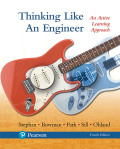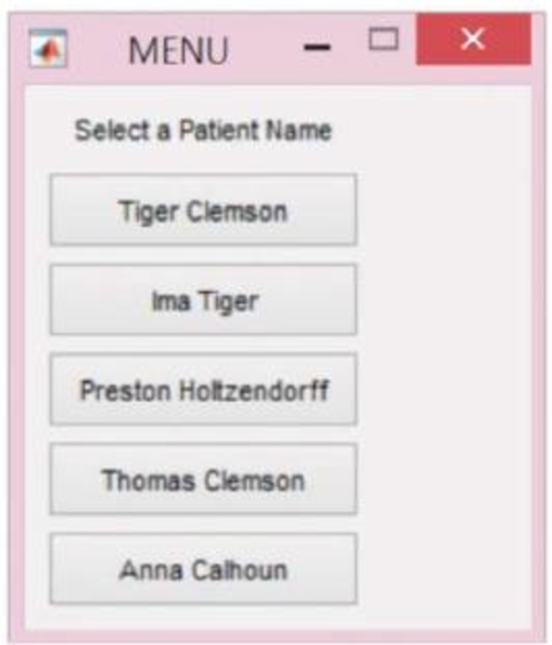
You are developing a program to record information about patients at a doctor’s office. Write the code to accomplish the following goals.
Section 1: Patient Information
Create a single-column cell array named Patients containing the names shown in the menu.
Determine the number of names in Patients and place the result in NumPat. Your code must determine how many names there are in Patients; DO NOT hard-code this value. Your code should still work correctly if the number of names stored in Patients changes.

Ask the nurse to choose the patient name being seen during an office visit from a menu of patient names, located in the cell array Patients. A menu with the current five names is shown here as an example.
Ask the nurse to enter the selected patient’s weight in pounds. This numeric value should be placed in a column
Create a text string named Gender consisting of a series of the letter X. The length of this text string should equal the number of names in Patients. For example, with the values stored in Patients given above, Gender would contain xxxxx.
Ask the nurse to enter the patient’s gender as a single letter chosen from M, F, T. (Some folks might argue vociferously concerning what categories should be included here, but this is just a homework assignment, not a philosophical discussion of gender identity and its classification, so chill out.) The letter typed by the nurse should REPLACE the corresponding X in the text string Gender. Thus if the nurse had selected Thomas Clemson and typed an M for gender, the text string Gender would then contain XXXMX , assuming no other patients’ information had been previously entered. Again, the nurse does not specify the location in the text string, the code does that.
Ask the nurse to enter the selected patient’s temperature [°F]. Place this numeric value in the corresponding element of a column vector named Temp. Thus if Thomas Clemson was selected and had a temperature of 98.7"F, the fourth element of Temp would then contain 98.7.
Section 2: Basic Report
Print a report on the screen similar to the following for the selected patient. Note that there is a blank line between the first line and the second line, and a blank line between the last line and the MATLAB prompt (>>). Also the last digit of the weight should be aligned beneath the "h" in "Weight", the gender identifier should be aligned under the letter d of "Gender", and the last digit of the temperature should be aligned under the "a" of "Temperature"
Patient: Thomas Clemson
Weight Gender Temperature
195 M 98.7
>>
Trending nowThis is a popular solution!

Chapter 17 Solutions
EBK THINKING LIKE AN ENGINEER
- Qu. 13 What are the indices for the Direction 2 indicated by vector in the following sketch? Qu. 14 Determine the indices for the direction A and B shown in the following cubic unit cell. please show all work step by step from material engineeringarrow_forwardThe thin-walled open cross section shown is transmitting torque 7. The angle of twist ₁ per unit length of each leg can be determined separately using the equation 01 = 3Ti GLIC 3 where G is the shear modulus, ₁ is the angle of twist per unit length, T is torque, and L is the length of the median line. In this case, i = 1, 2, 3, and T; represents the torque in leg i. Assuming that the angle of twist per unit length for each leg is the same, show that T= Lic³ and Tmaz = G01 Cmax Consider a steel section with Tallow = 12.40 kpsi. C1 2 mm L1 20 mm C2 3 mm L2 30 mm C3 2 mm L3 25 mm Determine the torque transmitted by each leg and the torque transmitted by the entire section. The torque transmitted by the first leg is | N-m. The torque transmitted by the second leg is N-m. The torque transmitted by the third leg is N-m. The torque transmitted by the entire section is N-m.arrow_forwardPlease help, make sure it's to box out and make it clear what answers go where...arrow_forward
 Elements Of ElectromagneticsMechanical EngineeringISBN:9780190698614Author:Sadiku, Matthew N. O.Publisher:Oxford University Press
Elements Of ElectromagneticsMechanical EngineeringISBN:9780190698614Author:Sadiku, Matthew N. O.Publisher:Oxford University Press Mechanics of Materials (10th Edition)Mechanical EngineeringISBN:9780134319650Author:Russell C. HibbelerPublisher:PEARSON
Mechanics of Materials (10th Edition)Mechanical EngineeringISBN:9780134319650Author:Russell C. HibbelerPublisher:PEARSON Thermodynamics: An Engineering ApproachMechanical EngineeringISBN:9781259822674Author:Yunus A. Cengel Dr., Michael A. BolesPublisher:McGraw-Hill Education
Thermodynamics: An Engineering ApproachMechanical EngineeringISBN:9781259822674Author:Yunus A. Cengel Dr., Michael A. BolesPublisher:McGraw-Hill Education Control Systems EngineeringMechanical EngineeringISBN:9781118170519Author:Norman S. NisePublisher:WILEY
Control Systems EngineeringMechanical EngineeringISBN:9781118170519Author:Norman S. NisePublisher:WILEY Mechanics of Materials (MindTap Course List)Mechanical EngineeringISBN:9781337093347Author:Barry J. Goodno, James M. GerePublisher:Cengage Learning
Mechanics of Materials (MindTap Course List)Mechanical EngineeringISBN:9781337093347Author:Barry J. Goodno, James M. GerePublisher:Cengage Learning Engineering Mechanics: StaticsMechanical EngineeringISBN:9781118807330Author:James L. Meriam, L. G. Kraige, J. N. BoltonPublisher:WILEY
Engineering Mechanics: StaticsMechanical EngineeringISBN:9781118807330Author:James L. Meriam, L. G. Kraige, J. N. BoltonPublisher:WILEY





